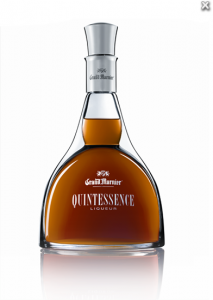My enthusiasm for the wines of Chile continues to grow, a long-smoldering ember fanned into flames by my trip there last fall, generously organized by Wines of Chile. These days our house wines are from Cono Sur and Conch Y Toro with a bottle of Montes Purple Angel for very special occasions. And my education was further expanded on Monday when I met with Javier Santos at Crush Wine Bar for a private tasting of some of the wines of Lapostolle, framed by other treasures produced by the Marnier-Lapostolle family.
The winery was founded in Chile’s Conchagua valley in 1996 by Alexandra Marnier-Lapostolle, sixth-generation descendant of the original creator of Grand Marnier. It seems to be a family tradition to add something important and original to the clan’s portfolio. Alexandra’s great-grandfather bought property in the Loire and founded Château Sancerre in 1910; her son, Charles de Bourné, now has a project of his own, making pisco in Chile’s luminous Elke valley, a pisco he calls Kappa, after the brightest star in the constellation of the Southern Cross.
We started the tasting with the 2011 Château Sancerre, a graceful, subtle, perfectly balanced wine. There was fresh lime and lemon zest on the nose, hovering over a distinctive minerality. The flavours echoed the bouquet, a swirl of complexity beneath the obvious elegance, reflecting the nine months the wine spent on its lees and the ripeness of a lovely vintage. The length showed the wine’s breeding and I was delighted to learn that it will be returning to the LCBO in the summer, priced very reasonably at around $25.
The next white was from Chile’s cool Casablanca valley, Lapostolle Cuvée Alexandre 2011 Chardonnay, made with organic grapes from the Atalayas vineyard. It’s another wine with a bouquet to make any oenophile’s nostrils flare in admiration. Half oak- and half steel-fermented, half oak-aged, no malo, it’s intense, rich, spicy but perfectly formed – a Olympian Chardonnay with oaky caramel braided around peach and pear aromas.
We tasted two red wines, both spectacularly aromatic, an effect enhanced by the splendid stemware Crush found for the occasion. Lapostolle Cuvée Alexandra 2008 Carmenere is splendid, the dominant varietal educated and smoothed with about 15% Merlot. The nose is redolent of plums and black fruits with smoky spice and a hint of dark chocolate. Tasting it, I was struck by the smoothness of the tannins and the ripe black fruit that didn’t seem to have faded at all with the passing years. Young Carmenere often has a hint of something ferous and bloody, the taste you experience when you cut your finger and suck the wound. I didn’t get that here, which may be due to the wine’s maturity.
Then we tasted Lapostolle’s unique Borobo 2009, a blend of Carmenere, Syrah, Cabernet Sauvignon, Pinot Noir and Petit Verdot that changes with the vintage, in terms of ratio. I tasted the 2005 a couple of years ago and loved the dark, liquorice spiciness behind the ripe black fruit. There was a sense of drying tannins behind the scenes, however, that had not managed to integrate themselves thoroughly. Not with the 2009 – a black velvet cloak to wrap around your palate.
So far, so very good, and now we moved on into the spirit world, enjoying a small snifter of Cognac Marnier VSOP as an introit into the Grand Marnier range. If you’ve noticed a change in your Grand Marnier over the last couple of years it’s because they have lowered the level of sweetness by a welcome and significant 20 percent, a decision that has helped bring Red Label Grand Marnier into the modern age. Now Javier Santos caused cocktails to be made to emphasize this refreshing, contemporary side to the old liqueur. The Grand Ginger was my favourite, a simple mix of 1 oz grand Marnier, 3 oz ginger ale and the juice of a ¼ of a lime stirred in a glass full of ice. The ginger ale brought out the flavour of the very rare, bitter, greenish-yellow type of oranges (Citrus bigaradia) that go into Grand Marnier, grown in the family’s groves in Haiti.
The next step up from the Red Label is the Grand Marnier Louis-Alexandre – my favourite level – which is smoother, more sophisticated and offers a greater ratio of Cognac to orange eau de vie in the blend, a virtue reflected in its price. We skipped the next two rungs of the ladder, the Cuvée de Centenaire and the Cuvée de Cent Cinquantenaire, created to mark the 100th and 150th anniversaries of the elixir. Instead we leaped right to the Quintessence, blended from double-distilled orange eau de vie and a selection of cognacs up to 100 years old that were discovered in the Marnier Paradis. This is the ultimate Grand Marnier experience. Can a smell be intense but also ethereal? Almost an incense of orange and oak and very old brandy. Texturally, it’s so smooth it is almost a syrup and the length is unparalelled. Remarkable. But dare I admit it – privately, and for your ear alone – I still prefer the Louis-Alexandre.


